
Partick Castle was located in Partick, now a Western suburb of Glasgow. It was built in 1611 for the Glasgow benefactor George Hutcheson and situated on the west bank of the River Kelvin. [1]

Partick Castle was located in Partick, now a Western suburb of Glasgow. It was built in 1611 for the Glasgow benefactor George Hutcheson and situated on the west bank of the River Kelvin. [1]
Writing in the early eighteenth century, Hamilton of Wishaw described the building:
"...where Kelvin falls into Clyde, is the house of Pertique, a well-built and convenient house, well planted with barren timber and large gardens, which are enclosed with stone walls, and which formerly belonged to George Hutcheson in Glasgow, but now to John Crawford of Myltoun." [2]
According to the local historian James Napier, it was left empty in 1770 and was unroofed and in ruins by 1783. [3] It was demolished during the 1830s. Another local writer records that its remains were removed in a single night to 'form dykes in the neighbouring fields'. This happened in 1836 or 1837. [4] Napier also provides an anecdotal description of the building in its later days when it was a tenanted property:
The account of the house given to me by a person who had often been in it when it was inhabited, was, that the under flat was partially sunk & vaulted. The second flat was entered by a few steps up, and had a stone floor laid on the arches. There were several apartments in this flat, which formed a sort of hostelry. The top flat had a deal floor and consisted of a large hall which was used for public gatherings, balls, and dancing parties, and over this flat were attics, which were used as bedrooms and for holding lumber. There was a well outside the house. The main entrance door was covered with large-headed nails, so also was a two-leafed door which formed the outer entrance to the grounds. The grounds being surrounded by a stone wall. [5]
A poem published locally (in the Glasgow Magazine or the Bee) in the nineteenth century describes it thus:
Lo, Partick Castle, drear and lone,
Stands like a silent looker-on,
Where Clyde and Kelvin meet;
The long rank grass waves o’er its walls;
No sound is heard within its halls,
Save noise of distant waterfalls,
Where children lave their feet." [6]
The castle's remains are likely to lie under the south-western end of the Tesco development site in Partick. [7] The site was most recently a scrapyard but before that a dye-works, a foundry and a laundry. Unlike most of the old village of Partick, the castle's site was not removed by the excavations involved in the construction of the now disused Partick Central railway station. Rather, the castle site's solum was preserved under the aforementioned industrial buildings. As part of Scottish Water's Glasgow environmental improvement programme, part of the castle was uncovered & excavated by GUARD Archaeology. [8]

According to some sources, the site of Hutcheson's building was also the site of a castle and country residence of the Bishops of Glasgow. This is the castle depicted on the former Burgh of Partick's coat of arms. In 1136, King David had granted to the land of Partick (Perdeyc) to the See of Glasgow. In 1362, a settlement of a dispute between the Bishop and his chapter house was made at his manor-house of Perthic. [9] Glasgow's Bishops continued to use their residence in Partick until the reformation in 1560, when Bishop James Beaton II fled to France from there, taking with him the sacred relics from Glasgow Cathedral. [10] The remains of that castle may have been discovered near the mouth of the River Kelvin during work to install sewage pipes in 2016. [11]
At the marriage of Sir George Elphinstone of Blythswood to Agnes Boyd in 1600, James VI promised the couple a bigger house. Sir George was given the New Park of Partick in order to manage the woodland, introduce deer, and build an 'ample' house for himself and for the king to resort to after hunting. This may have been built on the site of the Bishop's residence. [12]
There is some evidence that Partick was an important centre for the Kings of Alt Clut/Strathclyde. According to the Cistercian monk and hagiographer of St Kentigern, Jocelin of Furness, King Rhydderch had a residence in 'Pertnech' (Partick). Some archaeologists have deduced that the royal Partick estate was part of a larger elite centre of the kingdom, which included the ecclesiastical centre just across the River Clyde at Govan. [13] The lands of Partick remained royal property until King David granted them to the Bishops of Glasgow. [14]
There is no primary evidence that the site of Hutcheson's castle was the same as this royal residence.

Maryhill is an area in the north-west of Glasgow in Scotland. A former independent burgh and the heart of an eponymous local authority ward, its territory is bisected by Maryhill Road, part of the A81 road which runs for a distance of roughly three miles between Glasgow city centre and the suburban town of Bearsden.

Partick is an area of Glasgow on the north bank of the River Clyde, just across from Govan. To the west lies Whiteinch, to the east Yorkhill and Kelvingrove Park, and to the north Broomhill, Hyndland, Dowanhill, Hillhead, areas which form part of the West End of Glasgow. Partick was a Police burgh from 1852 until 1912 when it was incorporated into the city. Partick is the area of the city most connected with the Highlands, and several Gaelic agencies, such as the Gaelic Books Council are located in the area. Some ATMs in the area display Gaelic.
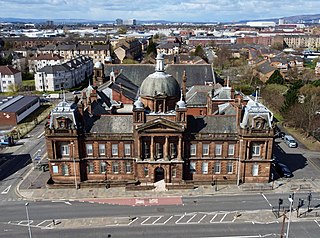
Govan is a district, parish, and former burgh now part of south-west Glasgow, Scotland. It is situated 2.5 miles (4.0 km) west of Glasgow city centre, on the south bank of the River Clyde, opposite the mouth of the River Kelvin and the district of Partick. Historically it was part of the County of Lanark.

Kelvindale is a district in the West End of the city of Glasgow, Scotland. Kelvindale shares the G12 postcode with the neighbouring residential districts of Kelvinside, Hillhead, Hyndland, Dowanhill, as well as Gartnavel General Hospital, Glasgow Clyde College (Anniesland) and the University of Glasgow, and is also close to the Anniesland and Wyndford areas of the city. The area is characterised by traditional interwar housing, formed of tenements and semi-detached houses.

Townhead is a district within the city of Glasgow, Scotland. It is one of Glasgow's oldest areas, and contains two of its major surviving medieval landmarks - Glasgow Cathedral and the Provand's Lordship.
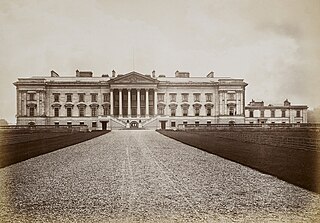
Hamilton Palace was a country house in Hamilton, South Lanarkshire, Scotland. It was the seat of the Dukes of Hamilton and is widely acknowledged as having been one of the grandest houses in the British Isles. The palace dated from the 14th century, was rebuilt in the Baroque style between 1684 and 1701 and was subsequently much enlarged in the Neoclassical style between 1824 and 1832.

Glasgow Botanic Gardens is a botanical garden located in the West End of Glasgow, Scotland. It features several glasshouses, the most notable of which is the Kibble Palace.
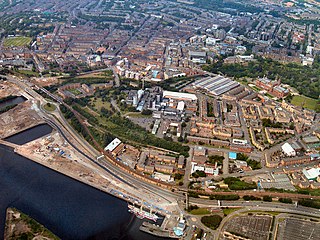
Yorkhill is an area in the city of Glasgow, Scotland. It is situated north of the River Clyde in the West End of the city. It is known for its famous hospitals and remains the location of the West Glasgow Ambulatory Care Hospital.
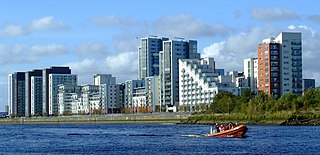
Glasgow Harbour in the following paragraphs is about a private sector urban regeneration scheme at Partick in the West End of the city of Glasgow, Scotland. It is not the history and development of the wider and internationally famous Glasgow Harbour from Glasgow Green to Clydebank which developed from the early 1800s and witnessed the birth and growth of modern shipbuilding and shipping.

The Clyde Walkway is a foot and mountain bike path which runs from Glasgow, Scotland, to just above the UNESCO World Heritage Site of New Lanark. The path runs close to the River Clyde for most of its length. It was completed in 2005, and is now designated as one of Scotland's Great Trails by NatureScot. The route is 65 kilometres (40 mi) long, and combines rural sections on the upper Clyde in South Lanarkshire, including the Clyde Valley Woodlands National Nature Reserve and the Falls of Clyde, with urban walking through the centre of Glasgow. About 155,000 people use the path every year, of whom about 7,750 undertake multi-day journeys including those covering the entire route.

Newark Castle is a well-preserved castle sited on the south shore of the estuary of the River Clyde in Port Glasgow, Inverclyde, Scotland, where the firth gradually narrows from the Firth of Clyde and navigation upriver is made difficult by shifting sandbanks. For centuries this location was used to offload seagoing ships, and led to the growth of Port Glasgow close to the castle on either side and to the south. When dredging techniques made the Clyde navigable as far as Glasgow the port became a shipbuilding centre, and the castle was surrounded by shipyards. Ferguson Shipbuilders, the last shipyard on the lower Clyde, stands close to the west of the castle, but the shipyards to the east were removed around the 1980s and new landscaped areas formed to the east of Newark Castle, opening up scenic views of the castle and across the Clyde from a new bypass road.

Partick is an interchange station in the Partick area of Glasgow, Scotland. Along with the adjacent bus station, it forms one of the main transport hubs in Glasgow. As of 2022, it is the fifth-busiest station in Scotland. The station is served by Glasgow Subway and ScotRail services and was one of the first to receive bilingual English and Gaelic signs, due to the significant Gaelic-speaking population in the surrounding Partick area.

Partick Central railway station was a station serving the Partick area of the city of Glasgow. Built in the 1890s by the Lanarkshire and Dunbartonshire Railway Company, it sat on a line that ran along the north bank of the River Clyde from Stobcross to Dumbarton.

The Riverside Museum is a museum in the Yorkhill area of Glasgow, Scotland, housed in a building designed by Zaha Hadid Architects, with its River Clyde frontage at the new Pointhouse Quay. It forms part of the Glasgow Harbour regeneration project. The building opened in June 2011, winning the 2013 European Museum of the Year Award. It houses many exhibits of national and international importance. The Govan-Partick Bridge, which will provide a pedestrian and cycle path link from the museum across the Clyde to Govan, is set to be completed in 2024.
This article deals with the history of the Partick area of Glasgow in Scotland.

The Memorial Gates at the University of Glasgow were erected in 1952 as a celebration of the university's quincentenary, or five hundredth anniversary. They form a portal through the University Avenue side of the perimeter fence around the university's current site on Gilmorehill. They stand before the Hunter memorial and Hunterian Museum, on the other side of the John McIntyre Building from the Main Gate. The large gates in the centre are generally locked, although the small pedestrian gates to the left and right are opened during the day. The gates bear the names of thirty distinguished figures associated with the university. The gates are protected as a category B listed building.
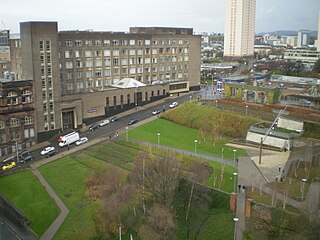
The John Anderson Campus, the main campus of The University of Strathclyde, is located in Glasgow, Scotland. The campus is self-contained in its own area which straddles the Townhead and Merchant City districts on the north eastern side of the city centre, while being only minutes from the M8 Motorway, George Square and is located midway between Queen Street Railway Station and High Street station on the North Clyde Line.
George Hutcheson, of Lambhill, Lanarkshire, was joint-founder with his younger brother Thomas Hutcheson, of Hutchesons' Hospital, Glasgow, which continues to live on today as the independent Hutchesons' Grammar School
White Inch was an island lying in the estuarine waters of the River Clyde close to Glasgow in the Parish of Govan, Lanarkshire, Scotland. Due to the deliberate disposal of dredged material from the Clyde, it became physically part of the northern, Lanarkshire side, of the river bank from the 1830s and is now entirely built over. The name lives on in the Whiteinch district of Glasgow, street names, etc., and probably relates to white colored sand deposits.